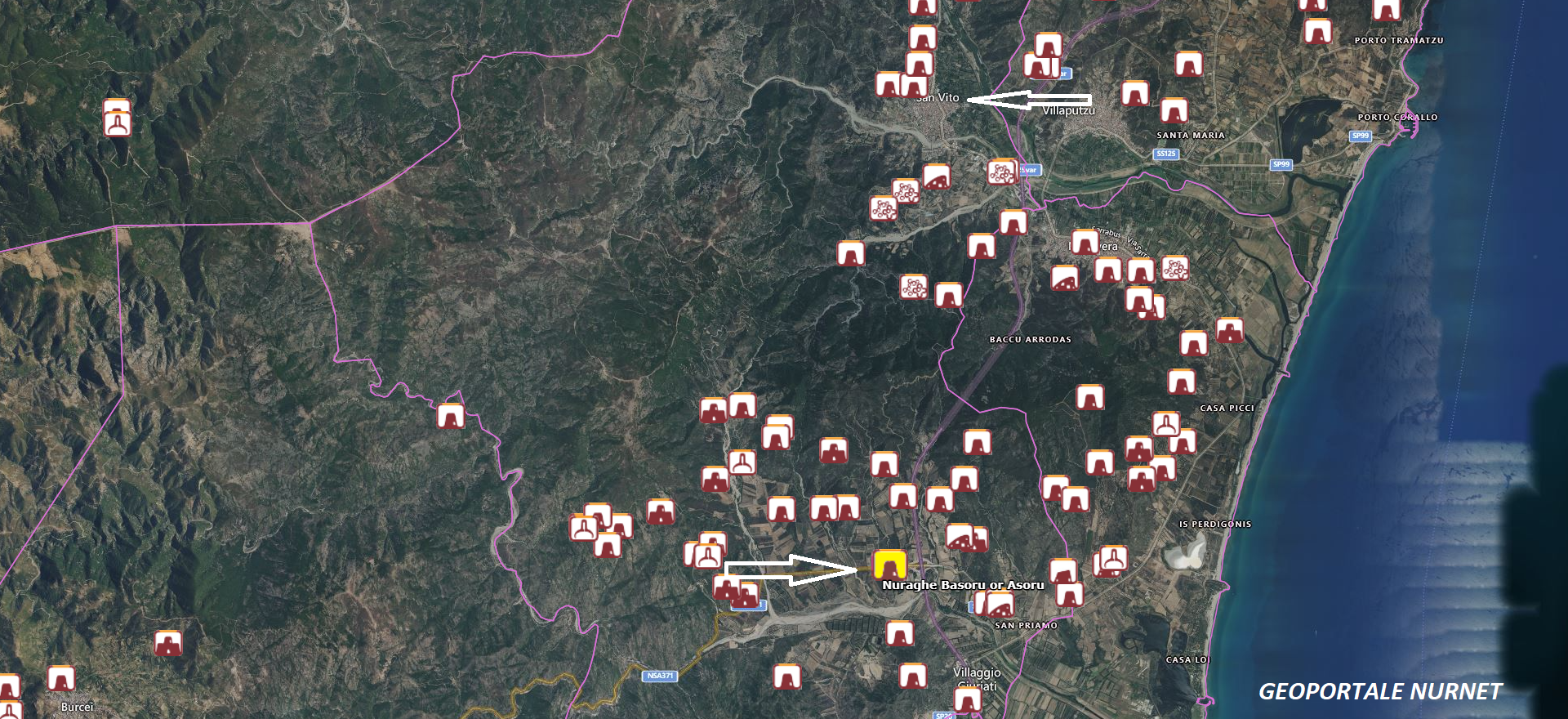 98b.2: The nuraghe Asoru or Basoru di San Vito is located in a valley basin surrounded by heights sloping down toward the sea of Colostri, at an altitude of 32 m above sea level. The structure consists of a keep to which, in later times, a trilobate bastion with a concave-convex shape was added, enclosing a small courtyard. The whole measures 24 m along the N-S axis and 16 m along the E-W axis. The keep, with a circular plan, is preserved to a maximum residual height of about 10 m. The masonry is made up of medium-sized porphyry blocks, roughly shaped and arranged in regular courses. The entrance to the monument, facing S-SE, is topped by a lintel equipped with a discharge window. The corridor behind it, partially filled with stones, flares inward and features projecting walls and a tabular closure. On the left wall of the corridor, the door to the staircase opens, inaccessible due to collapses. The chamber, lacking a roof and cluttered with stones, has a circular plan and a residual height of 7 m. Notably, the visible walls inside the chamber are those of the outer facing, as the inner one has mostly collapsed. The bastion, irregularly shaped, surrounds the keep with varying thickness, curving gently toward the west and forming an arc from north to east. The entrance, facing south, has collapsed and leads into a corridor 5 m long and flaring towards the inside, with a truncated-ogival section. On the left wall of the corridor, a niche can be seen among the debris. The courtyard, three-quarters elliptical, measures 4.50 x 3.40 m. The entrances to the keep open onto it and, although no longer visible because blocked by collapses, those of the secondary towers. The masonry of the bastion is preserved to a maximum height of about 5 m to the southeast (13 courses) and is different from that of the keep; in fact, the stones are worked with more care and the arrangement in courses is more regular. (Sardegna Cultura) The photos of the nuraghe Asoru are by Bibi Pinna, Nuraviganne, Diversamente Sardi, Francesca Cossu, and Lorenzo Muntoni.
98b.2: The nuraghe Asoru or Basoru di San Vito is located in a valley basin surrounded by heights sloping down toward the sea of Colostri, at an altitude of 32 m above sea level. The structure consists of a keep to which, in later times, a trilobate bastion with a concave-convex shape was added, enclosing a small courtyard. The whole measures 24 m along the N-S axis and 16 m along the E-W axis. The keep, with a circular plan, is preserved to a maximum residual height of about 10 m. The masonry is made up of medium-sized porphyry blocks, roughly shaped and arranged in regular courses. The entrance to the monument, facing S-SE, is topped by a lintel equipped with a discharge window. The corridor behind it, partially filled with stones, flares inward and features projecting walls and a tabular closure. On the left wall of the corridor, the door to the staircase opens, inaccessible due to collapses. The chamber, lacking a roof and cluttered with stones, has a circular plan and a residual height of 7 m. Notably, the visible walls inside the chamber are those of the outer facing, as the inner one has mostly collapsed. The bastion, irregularly shaped, surrounds the keep with varying thickness, curving gently toward the west and forming an arc from north to east. The entrance, facing south, has collapsed and leads into a corridor 5 m long and flaring towards the inside, with a truncated-ogival section. On the left wall of the corridor, a niche can be seen among the debris. The courtyard, three-quarters elliptical, measures 4.50 x 3.40 m. The entrances to the keep open onto it and, although no longer visible because blocked by collapses, those of the secondary towers. The masonry of the bastion is preserved to a maximum height of about 5 m to the southeast (13 courses) and is different from that of the keep; in fact, the stones are worked with more care and the arrangement in courses is more regular. (Sardegna Cultura) The photos of the nuraghe Asoru are by Bibi Pinna, Nuraviganne, Diversamente Sardi, Francesca Cossu, and Lorenzo Muntoni.











